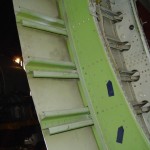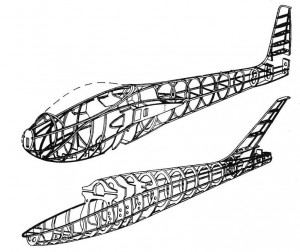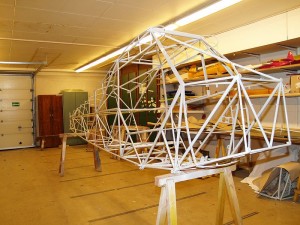 If you’re here, you likely already know a thing or two the general structure of an airplane: fuselage, wings, power-plant, empennage, and landing gear. Nevertheless, we’re going to cover the basics to ensure you have a good feel for each of the latter. If you ever intend to take an aircraft to flight, you’ll want to know it all inside-and-out.
If you’re here, you likely already know a thing or two the general structure of an airplane: fuselage, wings, power-plant, empennage, and landing gear. Nevertheless, we’re going to cover the basics to ensure you have a good feel for each of the latter. If you ever intend to take an aircraft to flight, you’ll want to know it all inside-and-out.
Fuselage
Think of the fuselage as the core structure of the aircraft. It is the area that holds the occupants of the aircraft, along with the controls for the plane. In some aircraft there may be cargo space as well, but that depends on the aircraft in question. Various designs may be used for the fuselage, namely: truss, monocoque, and semi-monocoque. We will discuss each of the later designs in greater detail below.
Truss Structure
The truss structure is comprised of “one or more triangular units constructed with straight members whose ends are connected at joints” (1). An example of this structure can be seen in the Piper PA-18. Typically in aircraft of this design the truss is made of aluminum alloy tubing or steel.
Monocoque Design
 In this design, the exterior surface of the aircraft supports most of the load (1,2). The term itself can be loosely translated from French to mean “single hull,” which seems to go along with the single mechanism of support for the structure. While the monocoque fuselage design image shows general design, there’s an example that was referenced (2) that more clearly illustrates this design for me. Think of a soda can. We’re all likely very familiar with this design. It is a monocoque design. You can put a relatively large amount of weight on top of a can that is upright, especially considering how thin the hull of the can is. Now place a small dent in the side of the can and try and put the same weight on the can. What you’ll likely see is the can will buckle under the pressure, as you’ve introduced a flaw into the structure. You can now see clearly why there are other designs that are used in most modern aircraft.
In this design, the exterior surface of the aircraft supports most of the load (1,2). The term itself can be loosely translated from French to mean “single hull,” which seems to go along with the single mechanism of support for the structure. While the monocoque fuselage design image shows general design, there’s an example that was referenced (2) that more clearly illustrates this design for me. Think of a soda can. We’re all likely very familiar with this design. It is a monocoque design. You can put a relatively large amount of weight on top of a can that is upright, especially considering how thin the hull of the can is. Now place a small dent in the side of the can and try and put the same weight on the can. What you’ll likely see is the can will buckle under the pressure, as you’ve introduced a flaw into the structure. You can now see clearly why there are other designs that are used in most modern aircraft.
Semi-Monocoque Design
 This method is the preferred method for an all-aluminum fuselage (3). If you were to picture any modern passenger jet, you’ve got an idea of how this completed design appears. A series of bulkheads / frames is set in a row in the shape of the fuselage. Supporting pieces of metal that run the length of the fuselage are called stringers. The structure is then wrapped with aluminum, and it is riveted into place, forming the stressed skin design that we saw in the monocoque design.
This method is the preferred method for an all-aluminum fuselage (3). If you were to picture any modern passenger jet, you’ve got an idea of how this completed design appears. A series of bulkheads / frames is set in a row in the shape of the fuselage. Supporting pieces of metal that run the length of the fuselage are called stringers. The structure is then wrapped with aluminum, and it is riveted into place, forming the stressed skin design that we saw in the monocoque design.
Wings
The design structures that were just discussed may have been difficult to picture at times, but surely this section will be more straight-forward. We’ve all see airplanes before. We know what wings are and what they look like. We likely even know that this is what keeps the airplane aloft; but did you we know why? The wings are airfoils and will have various shapes, depending on the aircraft on which they are being used (1, 4, 5). The airfoils of an aircraft are what produces lift; this is true across all forms of aviation. While it is the wings of planes, it is actually a helicopter’s rotor blades that perform the same function.
Aircraft with a double set of wings are called biplanes, whereas their singular counterparts are technically called monoplanes – although I suspect most of us just call them planes. Monoplanes can be either a high-wing design, like that of the Cessna, or a low-wing design like we’d see in the Piper PA-28 aircraft. Some high wing designs requires support braces, called struts, to be attached from the wing to the fuselage. These struts help provide support for the wings. If they are attached at half the length of the wing, they are referred to as semi-cantilever. These struts can be seen in the first image shown in the post.
Aircraft Power-Plant
Despite what you may think off-hand, the powerplant is more than just the engine of the aircraft. It actually consists of the propeller, the engine, a cowling covering the engine (if applicable), and ends at the plane’s firewall – in a single engine aircraft design.
Firewall
In single engine airplanes there is a firewall placed between the occupants and the engine. This firewall is similar to the design used in automotive vehicles. It protects the pilot and passengers in the case where the engine catches fire.
Empennage
 To the layperson, the empennage is commonly referred to as the tail section of the aircraft. But what exactly does this include, you may ask? There are several components which are illustrated in the following image. The components are: the horizontal and vertical stabilizer, the rudder, trim tabs, and the elevators. The rudder runs along the vertical stabilizer, while the elevator exists within the horizontal stabilizer. Each stabilizer has trim tabs. During flight, the ailerons and the rudder work in conjunction to produce smooth, non-slipping, turns. Whereas the elevators control the pitch of the airplane during flight (up or down).
To the layperson, the empennage is commonly referred to as the tail section of the aircraft. But what exactly does this include, you may ask? There are several components which are illustrated in the following image. The components are: the horizontal and vertical stabilizer, the rudder, trim tabs, and the elevators. The rudder runs along the vertical stabilizer, while the elevator exists within the horizontal stabilizer. Each stabilizer has trim tabs. During flight, the ailerons and the rudder work in conjunction to produce smooth, non-slipping, turns. Whereas the elevators control the pitch of the airplane during flight (up or down).
Landing Gear
Last but not least, let us not forget about the landing gear. After all, it is a critical component of the airplane during takeoff, landing, and taxiing. The landing gear can be retractable or fixed. Furthermore, the landing gear itself can be anything from wheels, to floats for landing on lakes, to skis for landing in snowy conditions – this is all dependent on the plane and its usage. Planes commonly have three wheels, with two in the middle of the plane (when viewed from the side) and a third located at the front or rear of the plane. If the third wheel is at the rear of the plane it is referred to as conventional landing gear – or more commonly called a tailwheel airplane. If the third wheel is at the front of the plane is is called a nosewheel and is in a tricycle configuration.
References:
- Pilot’s Encyclopedia of Aeronautical Knowledge, FAA-H-8083-25A.
- Wikipedia, Truss
- http://en.wikipedia.org/wiki/Fuselage
- Your Pilot’s License, Eichenberger, 2003.
- http://en.wikipedia.org/wiki/Airfoils


